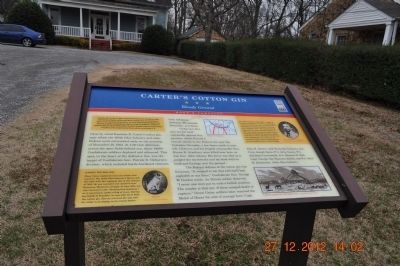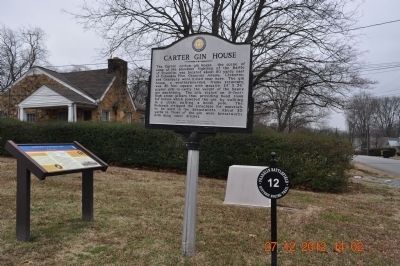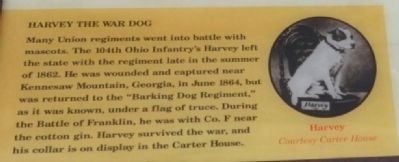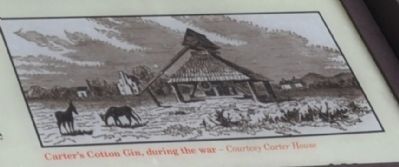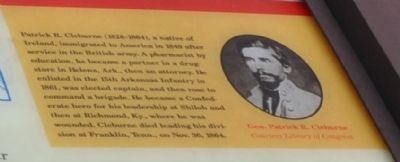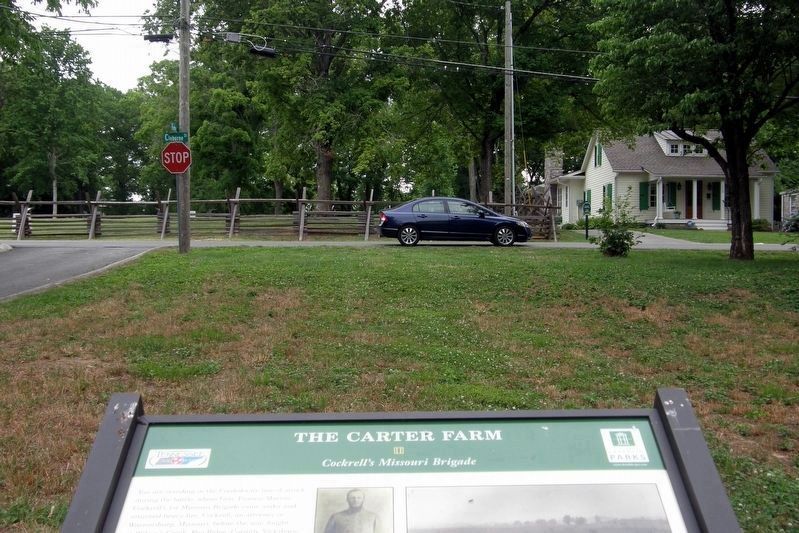Franklin in Williamson County, Tennessee — The American South (East South Central)
Carter's Cotton Gin
Bloody Ground
— Hood's Campaign —
(Preface): In September 1864, after Union Gen. William T. Sherman defeated Confederate Gen. John Bell Hood at Atlanta, Hood let the Army of Tennessee northwest against Sherman's supply lines. Rather than contest Sherman's "March to the Sea," Hood moved north into Tennessee. Gen. John M. Schofield, detached from Sherman's army, delayed Hood at Columbia and Spring Hill before falling back to Franklin.The bloodbath here on November 30 crippled the Confederates, but they followed Schofield to the outskirts of Nashville and Union Gen. George H. Thomas's strong defenses. Hood's campaign ended when Thomas crushed his army on December 15-16.
Close by stood Fountain B. Carter's cotton gin, near which the 104th Ohio Infantry and other Federal units entrenched early on the morning of November 30, 1864. At 4:00 that afternoon, across the open fields behind you, about 19,000 Confederate soldiers deployed and advanced. This spot, in the heart of the defensive line, was the target of Confederate Gen. Patrick R. Cleburne's division, which included battle-hardened veterans from Arkansas, Alabama, Mississippi, Tennessee, and Texas.
Cleburne's division hurled itself repeatedly against this position, which formed a crucial salient in the Federal line near the Columbia Turnpike, a few dozen yards to your left. Cleburne and his brigade commander Gen. Hiram B. Granbury were killed near here, as was Gen. John Adams. His horse was shot as it jumped the earthworks and lay dead with its head and forelegs over the parapet.
The Federal defense at the cotton gin was ferocious. "It seemed to me that hell itself had exploded in our faces," Confederate Gen. George W. Gordon wrote. An Illinois soldier observed, "I never saw men put in such a hellish position. The wonder is that any of them escaped death or capture." Seven Union soldiers later received the Medal of Honor for acts of courage here: Capt. John H. Brown, 12th Kentucky Infantry, and Corp. Joseph Davis, Pvt. John Gaunt, Pvt. Abraham Greenawalt, Pvt. Newton H. Hall, Capt. George Van Stavoren Kelley, and Pvt. John H. Ricksecker, 104th Ohio Infantry.
(Sidebar): Harvey the War Dog
Many Union regiments went into battle with mascots. The 104th Ohio Infantry's Harvey left the state with the regiment late in the summer of 1862. He was wounded and captured near Kennesaw Mountain, Georgia, in June 1864, but was returned to the "Barking Dog Regiment," as it was known, under a flag of truce. During the Battle of Franklin, he was with Co. F near the cotton gin. Harvey survived the war, and his collar is on display at the Carter House.
(Sidebar Two): Patrick R. Cleburne (1828-1864), a native of Ireland, immigrated to America in 1849 after service in the British army. A pharmacist by education, he became a partner in a drug-store in Helena, Ark., then an attorney. He enlisted in the 15th Arkansas Infantry in 1861, was elected captain, and then rose to command a brigade. He became a Confederate hero for his leadership at Shiloh and then at Richmond, Ky., where he was wounded. Cleburne died leading his division at Franklin, Tenn., on Nov. 30, 1864.
Erected by Tennessee Civil War Trails.
Topics and series. This memorial is listed in these topic lists: Animals • War, US Civil. In addition, it is included in the Tennessee Civil War Trails series list. A significant historical month for this entry is June 1864.
Location. Marker has been reported missing. It was located near 35° 54.927′ N, 86° 52.356′ W. Marker was in Franklin, Tennessee, in Williamson County. Memorial was on Cleburne Street, on the right when traveling west. Touch for map. Marker was in this post office area: Franklin TN 37064, United States of America. Touch for directions.
Other nearby markers. At least 8 other markers are within walking distance of this location. The Carter Farm (a few steps from this marker); a different marker also named The Carter Farm (within shouting distance of this marker); a different marker also named The Carter Farm (within shouting distance of this marker); a different marker also named The Carter Farm (within shouting distance of this marker); a different marker also named The Carter Farm (within shouting distance of this marker); a different marker also named The Carter Farm (within shouting distance of this marker); a different marker also named The Carter Farm (within shouting distance of this marker); a different marker also named The Carter Farm (about 300 feet away, measured in a direct line). Touch for a list and map of all markers in Franklin.
Also see . . . Patrick Cleburne. Patrick Ronayne Cleburne (/ˈkleɪbɜrn/ klay-burn; March 16 or March 17, 1828[1] – November 30, 1864) was an Irish American soldier, best known for his service in the Confederate States Army during the American Civil War, where he rose to the rank of major general. (Submitted on June 16, 2014, by Sandra Hughes Tidwell of Killen, Alabama, USA.)
Credits. This page was last revised on July 28, 2019. It was originally submitted on January 3, 2013, by Sandra Hughes Tidwell of Killen, Alabama, USA. This page has been viewed 820 times since then and 18 times this year. Last updated on July 28, 2019, by Larry Gertner of New York, New York. Photos: 1, 2, 3, 4, 5. submitted on January 3, 2013, by Sandra Hughes Tidwell of Killen, Alabama, USA. 6. submitted on July 28, 2019, by Larry Gertner of New York, New York. • Bernard Fisher was the editor who published this page.
